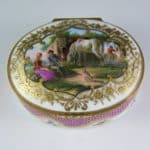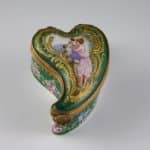Collecting Antique Snuff Boxes
Story and Photos by Donald-Brian Johnson
Hmmmm…
Just what are those elaborate little boxes intended for, anyway?
Trinkets? Change? Cufflinks and earrings? Breath mints?
The answer: none of the above.
These exquisite examples of design artistry are actually snuff boxes, the must-have fashion accessory which took the world by storm, during the 18th and 19th centuries.
During their heyday, the popularity of snuff boxes was nothing to sneeze at.
Dapper Dans and modish maidens would no more think of appearing in public without their snuff boxes than they would without their handkerchiefs, (a definite necessity in the days when taking snuff was all the rage). The habit itself may have been unsightly; the boxes, however, were a wonderful sight to behold.
The Nose Knows
For the uninitiated, snuff is best described as the original “smokeless tobacco:” finely powdered tobacco leaves, which are ingested by sniffing, rather than smoking. A pinch of snuff is gathered up in the fingers, then inhaled (or “snuffed”) through the nose. The ground tobacco is generally made more nasally palatable through the addition of flavoring. Among the most popular choices in early days: fruit, spice, floral, and “medicated” (i.e., menthol), the flavors used either alone or in combination. Also in the mix: spearmint, cinnamon, rose, and even camphor-flavored snuffs.
There were very finely ground snuffs, and coarser varieties, as well as very dry (“toast”) to very moist versions. The drier the snuff, the greater chance it would elicit sneezing – and the greater need for the snuff-taker’s ever-present friend, the handkerchief.
So, how did the snuff habit become habit-forming? Well, we could always blame it on Columbus. The intrepid explorer and his fellow-travelers are credited with first transporting snuff across the ocean, from the New World to the Old. On a stopover in Haiti during the second Columbian voyage to the Americas (1493-96), natives were observed sniffing the substance. Columbus and company couldn’t resist giving it a try, and a die-hard habit was cast.
Although initially regarded as an unseemly practice indulged in only by the lower classes, (some early sailors were actually paid in snuff), snuff-taking quickly proved upwardly mobile. Drawn to the scent: the aristocracy of Portugal, Spain, France, England, and eventually such Eastern entities as Russia and China. In the 1560s, Catherine de’Medici of France was persuaded to try snuff as a remedy for her son’s migraines. Whether or not snuff effected the cure Catherine had been looking for is open to debate. What’s important is that she believed it did. Her support helped remove the snuff stigma, ensuring its popularity among the nobility.
Soon everyone (or at least everyone who could afford it) was using snuff. Napoleon did, prompting his regular appearances as a snuff-box portrait cover boy during the early 1800s. So did King Louis XIII of France, Queen Charlotte of England (wife of King George III), and Pope Benedict XIII. Members of the British House of Commons had their own special blend of snuff: “English Rose”, paid for by the public as a peace offering, following a 1693 ban on smoking in the House. (During World War II, when the communal silver snuff box used by House members was demolished in an air raid, Winston Churchill donated a new one. Such oversize snuff boxes, or “mulls”, often featuring silver-emblazoned rams’ horns, also proved popular with the party-throwing, well-heeled gentry.)
There were, of course, naysayers along the way. During the 1600s, Pope Urban VIII (evidently of a different mindset than the yet-to-come Pope Francis) decreed excommunication for any snuff takers among his flock. In Russia, the punishment was even more severe: a 1643 edict by Tsar Michael threatened that persons using snuff would have their noses cut off! As early as the 1700s, John Hill, an English physician, was noting an upsurge in nasal cancers among overzealous snuff-takers. And in 1794, the newly independent United States of America took a feisty stand against “aristocratic indulgence” by issuing the country’s first-ever tobacco tax – on snuff.
But taxed or not, snuff’s popularity continued unabated for the next century or so. For every doomsayer’s pronouncement, there were equally vigorous defenses offered by snuff partisans. Gentlewoman’s Magazine, a British publication of the 1700s, went so far as to recommend that any squinting readers adopt a regular snuff-taking protocol, since “many eminent people have cured themselves so that they can read without spectacles, even after having used them for many years.”
All Boxed Up
The real burning issue of the time, however, was how best to carry the stuff. With prolonged exposure to air, snuff had a tendency to dry out, losing whatever flavoring it had been infused with. Carting about more than a day’s worth of snuff had the same result, with the added detriment of unpleasant staleness. What was needed was a small, airtight container, of a material guaranteed not to absorb the properties of the material it held. The answer: the snuff box!
“Pocket” snuff boxes, in the two to three inch range, were compact enough for easy transport. Hinged lids kept the day’s supply fresh, while also eliminating the chance of losing a separate top. Materials used for the boxes ranged from the inexpensive (horn, wood), to the much more valuable (brass, copper, tortoise shell, ivory), to combos of the varied elements, and cloisonné arrangements. Most desirable (and costly) were snuff boxes which incorporated gold or silver, or were encrusted with jewels. Those whose fingers were too pudgy to fit into a tiny snuff box could make use of the ultimate snuff accessory: the even tinier silver snuff spoon, just the right size for transferring snuff from the box to the fingers, or to the back of the hand, en route to its intended destination.
Handle With Care
Among the most collectible (and fragile) snuff boxes are those fashioned of porcelain with metal fastenings. Porcelain snuff boxes are often art galleries in miniature. Extremely detailed paintings, usually by uncredited artists, adorn not only the box lids, but often also the sides, base, interior lid, and bottom. Many of the scenes depicted focus on idealized visions of bucolic life: wistful shepherdesses and virile shepherds; merry-makers in a pub; couples at leisure along a riverbank, with sailing ships and fairy-tale castles forming an idyllic background. “Classical” images were also popular: toga-clad Romans and Greeks, enacting scenes from long-forgotten allegorical tales. Simpler visuals included portrait insets of notables of the time (enter “Napoleon”) or dustings of colorful flowers, sometimes accented by interior precious-metal bands, or enameled directly on the metal linings. Box shapes varied from the to-be-expected rectangular or round, to the more stimulating: shells, hearts, vases, urns, and even cornucopias. (In China, the snuff box of choice was actually a snuff bottle).
The value of the porcelain snuff box has only increased because of its fragility: delicate and prone to breakage, few have survived the years intact. Especially prized are those with elements that depart from the norm. Snuff boxes that can be verified as once belonging to a historical personage, for example, are eagerly sought after, although most of these find their way into museum collections. (One royal prince was noted for using twelve snuff boxes – daily – a different box for each of his twelve favored snuff blends.)
Other collector-pleasers: snuff boxes featuring a family crest, and “common man” snuff boxes (inexpensive then, not at all inexpensive now) embellished with a silver coin pinpointing the date of manufacture. Snuff boxes were even, at times, incorporated into jewelry, although the small size required for this usage usually negated their practicality.
Although nominally a “useful” accessory, the snuff box was obviously prized more highly for the decorative expertise that went into is creation than for its ability to hold pulverized tobacco. The Renaissance nobility had pendant jewels; Russian royalty of the late 1800s had Faberge eggs; the upper echelons of society, from the mid-1700s until the mid-1800s, had snuff boxes. During that era, the decorative snuff box was, in essence a part of daily costume, an item “worn” to complete a desired look, rather than added as an afterthought. Much snuff box production was centered in Paris, then, as now, a fashion capital. Prevailing style trends played as big a role in determining snuff box design as they did in the cut of a gown, or the amplitude of a sleeve.
By the late 1800s, the ever-changing winds of fashion had once more shifted; snuff-taking (and its accompanying elaborate accouterments) fell out of favor. Popular culture soon identified snuff-takers only with irascible old codgers, those weather-beaten, gap-toothed sidekicks in movie Westerns. Even Thomas Edison used snuff-taking for comic effect: a famed 1894 Edison Kinetoscope, one of the earliest examples of a “moving picture” features a gentleman named Fred Ott taking a pinch of snuff, and then sneezing. And that’s all he does.
Today, with stringent anti-smoking ordinances widespread, snuff-taking has seen a minor resurgence. The elegant boxes of the past have, of course, been replaced by the utilitarian. Even less glamorous: aluminum or plastic “snuff bullets”, each delivering its dosage with the twist of a dial. There’s even a barroom novelty, the “snuffing machine,” which allows an entire raucous crowd to partake. And new, lowbrow snuff flavorings have joined the ranks of standbys from the past. Among them: “Cola,” “Cherry,” and, one sure to open those nasal passages, “Bourbon.”
Although their original purpose has long-since been debunked, antique snuff boxes retain major collectability today as art objects. Value is dependent on age, materials used, and intricacy of detail, with prices ranging from several hundred dollars to several hundred thousand dollars for extremely rare, museum-quality boxes. Their delicate, lavishly decorated stylings, coupled with a lengthy and interesting history, make snuff boxes true design treasures – a claim that can never be snuffed out.
Donald-Brian Johnson is the co-author of numerous books on design and collectibles, including “Postwar Pop”, a collection of his columns, and an upcoming second volume. Please address inquiries to: donaldbrian@msn.com.









Related posts: